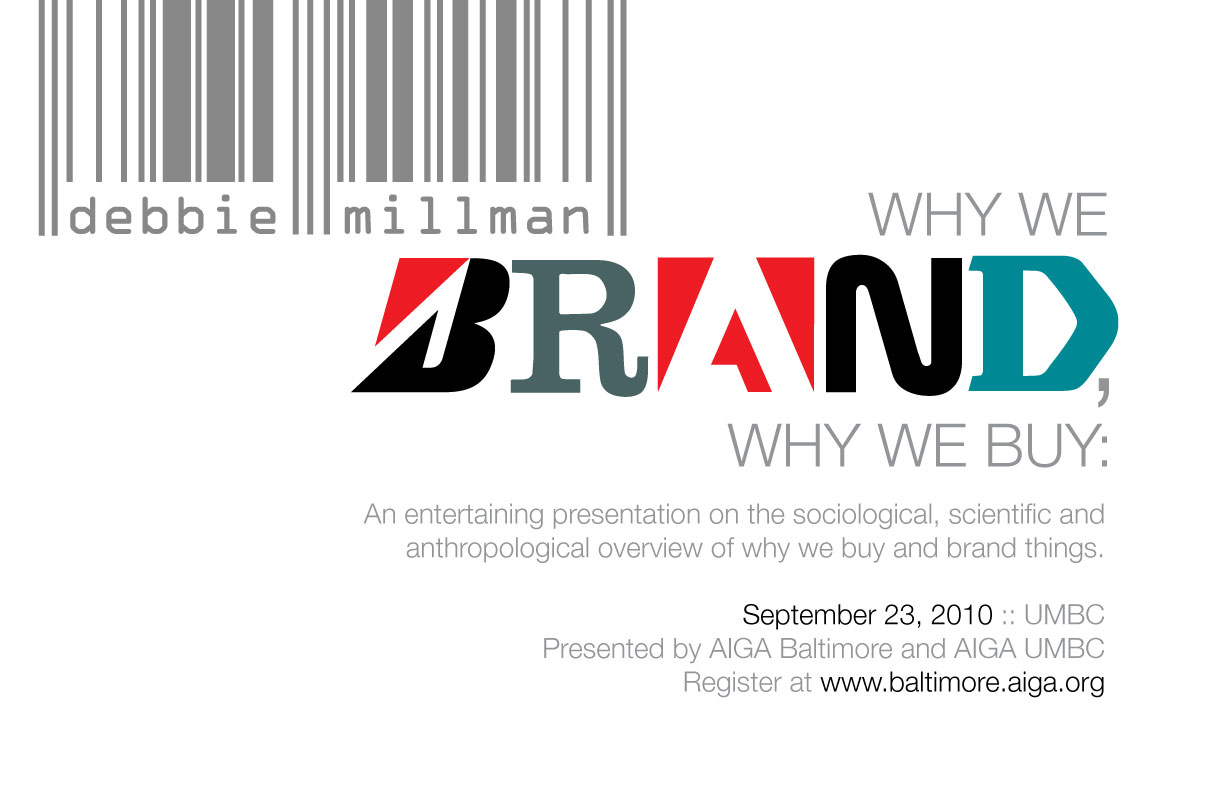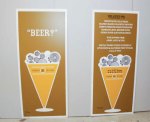
Discussing Business, we have an interview with Debbie Millman, president of AIGA. She hosts the podcast, ‘Design Matters’ and has been in the design business for 25 years. She regularly blogs on topics related to the field at http://debbiemillman.blogspot.com, she is a Partner and President of the Design division at Sterling Brands, and she is the Chair of the new Masters in Branding program at the School of Visual Arts in NYC. And she answers a few questions for us.
Q: Using the AIGA Confidence Index (http://www.aiga.org/content.cfm/confidence-index) the economy was at about its worst point (50 out of 100) approximately one year ago October 2008. With confidence in business low and similarly design as a profession, how do you think the emerging role of designers has been affected?
A: Downturns such as the one we are in are times when designers can make the most difference. One of the biggest tcchnological and cultural innovations in the last ten years came during the last big recession: Apple’s iPod. Believe it or Steve Jobs launched the iPod 6 weeks after 9/11.
Recessionary times come with new needstates and the requirement for new solutions to the problems we face. Designers are the most qualified people to solve those problems.
Every problem our planet faces is cinematic because it gets swept up in to a swift sequence of gestures that precede and follow it. Sort of the ultimate domino effect. Our ability to effect change is greater than it has ever been. And I am not talking about iPods here! Rather than our culture being a prisoner of politics, design can be an inspiration to our culture. An opportunity to constantly reach for higher ground.
Q: Speaking at the recent leadership conference, you mentioned that your legacy is focused on “connectivity”. How does the value of connectivity relate to AIGA?
A: The way in which we humans connect with each other has changed forever. Just in this country alone, we went from three television channels to over 500 hundred channels, from no web pages to billions. It took 35 years for 150 million people to own televisions. It took only 7 years for 150 million people to own cell phones. And it will likely take only take 3 years for 150 million people to sign up for Twitter. The average teenager sends over 2500 text messages! The structural frameworks of the way we live, communicate and organize ourselves has fundamentally changed and I am committed to charting a new connective structure for AIGA that is authentic, transparent and meaningful. I believe that some of the most exciting things happening within AIGA are in the local chapters. The entire membership should be aware of this great activity and benefit from it. I also believe that there is great opportunity for younger designers to benefit from the access to more established designers for mentorship, job opportunities and training. So I am working on instilling new practices in the way the entire 20,000 plus membership is communicating and connecting.
Q: You’ve conversed with alot of great designers (and others) in your work. Are there common denominators that connect legendary work despite the different backgrounds, approaches and challenges?
A: One of the ironic and fascinating common denominators is that most legendary designers, no matter what the background, approach or challenge, everyone deeply, rigorously questions the validity and quality of their work. Other than Massimo Vignelli and Milton Glaser (who are both in their 70s), everyone I have interviewed worries about the quality and meaning of their work. Everyone is insecure. Everyone wonders if they are good enough or smart enough or courageous enough. Everyone.
Q: How does the “new economy” and the requisite valuations of the work designers do relate to designers in the trenches in their effort to create great work?
A: Designers today experience a condition of ambiguity and compromise— building, aiding, and abetting what we now call “the new economy” seems an inevitable consequence of our work. Prospects of that condition changing seem remote. Especially if we want to build groovy offices and pay talented staffs.
But, Chris, I have to ask: what is the definition of ‘great work’? I looked back to the 1964 design manifesto, First Things First to find an answer. Originally written by British designer Ken Garland and twenty-one of his design colleagues, the manifesto boldly encouraged students, designers and teachers to reconsider their opportunities outside the noise and “high-pitched scream of consumer selling” in favor of applying their talents to promote education, culture and a greater awareness of the world. This was not intended to advocate the abolition of contemporary design, but was simply a call for the re-evaluation of our profession’s priorities. So rather than only applying our skills to selling dog biscuits, designer coffee, diamonds, instant film, french fries, detergents, hair gel, cigarettes, credit cards, sneakers, light beer, and heavy-duty recreational vehicles, they tried to inject passion, truth and reality into their design work. But herein lies the inherent dichotomy with that statement.There will always be a need to design dog biscuits and hair gel and french fries! And despite what many marketers now believe, a computer is not the only tool you need to do this. We must…we HAVE to inject passion, truth, reality and integrity to this work as well. All design—no matter where and what it is, has the power to inspire us to think and grow, to teach us what we don’t know and to inform and remind us of what is truly important. And what is important is honesty. What we need to create, in response to the torrential acceleration of this new economy is honesty.
Q: Esquire does a feature called “What I Learned”. Well, what two things have you learned about business that are on the tip of your tongue?
A: Work harder than anybody else that you know.
Shoot for the stars. Seriously. So many people start out by thinking about all the things that they can’t do and once you take that path, it’s very hard to get off of it. The only person that can make every dream that you want to come true is you. And if you start out with limited dreams, you’ll only achieve limited dreams. And that’s really sad when that happens.
Debbie is author on the design blog Speak Up, a regular contributor to Print Magazine and she hosts a weekly internet radio talk show on the Design Observer Media Channel titled Design Matters. Her first book, “How To Think Like A Great Graphic Designer,” was published by Allworth Press in 2007; her second, “Essential Principles of Graphic Design,” was published by Rotovision in 2008, and a book of illustrated essays titled “Look Both Ways” will be published in the Fall. Debbie can be reached at debbie.m@sterlingbrands.com
She’ll be in Baltimore speaking September 23rd.
 Equipped with yellow Neenah Paper shopping bags (instead of pillow cases or those jack-o’-lantern plastic baskets that seemingly every child owned growing up), attendees moseyed from table to table. More than 20 vendors shared information on design services and the latest trends in papers while a local microbrewery offered free hops.
Equipped with yellow Neenah Paper shopping bags (instead of pillow cases or those jack-o’-lantern plastic baskets that seemingly every child owned growing up), attendees moseyed from table to table. More than 20 vendors shared information on design services and the latest trends in papers while a local microbrewery offered free hops. proceeded home to pour out their goodies on the floor and share with friends.
proceeded home to pour out their goodies on the floor and share with friends.











